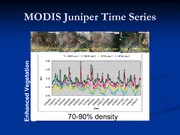
NASA Technical Reports Server (NTRS) 20110008805: Integration of Airborne Aerosol Prediction Systems and Vegetation Phenology to Track Pollen for Asthma Alerts in Public Health Decision Support Systems PDF
Preview NASA Technical Reports Server (NTRS) 20110008805: Integration of Airborne Aerosol Prediction Systems and Vegetation Phenology to Track Pollen for Asthma Alerts in Public Health Decision Support Systems
Integration of Airborne Aerosol Prediction Systems and Vegetation Phenology to Track Pollen for Asthma Alerts in Public Health Decision Support Systems Jeffrey C Luvall Marshall Space Flight Center William A. Sprigg, Alfredo Huete, Goran Pejanovic, Slobodan Nickovic, Guillermo Ponce-Campos, University of Arizona, Heide Krapfl Environmental Health Epidemiology Bureau, NM Department of Health Amy Budge Earth Data Analysis Center, Alan Zelicoff, Dept of Family & Community Medicine, Orrin Myers University of New Mexico ARES Corporation Peter K. Van de water California State University, Fresno Estelle Levetin Dept. Biology University of Tulsa Theresa Crimmins & Jake Weltzin USGS National Phenology Network Top pollen-producing species Los Alamos Albuquerque mulberry juniper juniper ssaaggeebbrruusshh ash pine goosefoot Alternaria* cottonwood oak grass grass ssaaggeebbrruusshh ragweed pine goosefoot elm Cladosporium* aster Myxomycete* ragweed cottonwood sycamore mulberry oak aster willow elm *fungal / slime mold spores Burkard Spore Trap Sampling Limitations of Pollen • Lack of stations • Count frequency & reporting lag time • Different sampling instruments Rotorod Sampler/Burkard Spore Trap • Only indentifiable pollen “grains” • Expertise in counting/indentification • Refusal to release sampling information-”We do not reveal the sources for our data for privacy and proprietary, competitive reasons. Some pollen counts are conducted privately, and are not meant to be broadcast to the public” Pollen Timing • Growing Degree Days - the average of the daily maximum and minimum temperatures compared to a base temperature, T , (usually 10 °C) base • Response to length of day • Species differences • Climate – Variability in Precipatation • Weather Airborne Dust Simulations and Forecasts University of Arizona With NASA Earth System Science & University of New Mexico Phoenix dust storm – 7 June 2006 Photo by Robb Schumacher Arizona Republic Department of Atmospheric Sciences http://www.atmo.arizona.edu/faculty/research/dust/dust.html WWeeaatthheerr -- DDRREEAAMM Dust REgional Atmospheric Modeling (DREAM) system MMMM55 WWRRFF S. Nickovic et al., A model for prediction of desert dust cycle in the atmosphere, JGR 106, 18113–18129 (2001) . Yin et al., Modeling wind-blown desert dust in the southwestern United States for public health warning: A case study, Atmos. Environ. 39, 6243-6254 (2005). Yin et al.,The impact of using different land cover data on wind-blown desert dust modeling results in the southwestern United States Atmos. Environ., 41, 2214-2224 (2007). UA WRF 10-m wind forecast Adapted from Betterton ppt W.A.Sprigg for MSFC June ‘08 Phenology and Pollen Transport NASA MODIS data DREAM – UofA numerical meteorological particulate transport model Pollen sources derived from phenological maps Final Product – predicted concentrations of pollen in time and space http://www.atmo.arizona.edu/research/dust/dust.html
